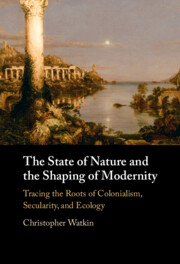Refine search
Actions for selected content:
162 results
Chapter 1 - Competing Nostalgias and Irish Identity in James Joyce’s Ulysses
-
- Book:
- Nostalgia and National Identity in the British and Irish Modernist Epic
- Published online:
- 27 November 2025
- Print publication:
- 18 December 2025, pp 25-53
-
- Chapter
- Export citation
1 - What Is the State of Nature?
- from Part I - Making Sense of the State of Nature
-
- Book:
- The State of Nature and the Shaping of Modernity
- Published online:
- 19 November 2025
- Print publication:
- 18 December 2025, pp 27-74
-
- Chapter
- Export citation
24 - The Poetry of Antarctica
-
-
- Book:
- The Cambridge History of Australian Poetry
- Published online:
- 19 November 2025
- Print publication:
- 11 December 2025, pp 457-475
-
- Chapter
- Export citation
7 - Settler Labour Poetics and the National Imaginary at the Turn of the Twentieth Century
-
-
- Book:
- The Cambridge History of Australian Poetry
- Published online:
- 19 November 2025
- Print publication:
- 11 December 2025, pp 137-149
-
- Chapter
- Export citation

The State of Nature and the Shaping of Modernity
- Tracing the Roots of Colonialism, Secularity, and Ecology
-
- Published online:
- 19 November 2025
- Print publication:
- 18 December 2025
Chapter 6 - Tragedy and Death in the Phaedo
-
- Book:
- Plato on Comedy and Tragedy
- Published online:
- 24 October 2025
- Print publication:
- 13 November 2025, pp 188-219
-
- Chapter
- Export citation
2 - Literary Form
- from Part I - First Principles: What Is a Gospel, According to Origen?
-
- Book:
- The Life of Jesus in the Writings of Origen of Alexandria
- Published online:
- 26 September 2025
- Print publication:
- 16 October 2025, pp 17-37
-
- Chapter
- Export citation
3 - Literary Formation
- from Part I - First Principles: What Is a Gospel, According to Origen?
-
- Book:
- The Life of Jesus in the Writings of Origen of Alexandria
- Published online:
- 26 September 2025
- Print publication:
- 16 October 2025, pp 38-62
-
- Chapter
- Export citation
1 - What Is a Gospel?
- from Part I - First Principles: What Is a Gospel, According to Origen?
-
- Book:
- The Life of Jesus in the Writings of Origen of Alexandria
- Published online:
- 26 September 2025
- Print publication:
- 16 October 2025, pp 5-16
-
- Chapter
- Export citation
Chapter 13 - Big House Revivals
- from Part III - Mythologies of the Literary Revival
-
-
- Book:
- The Revival in Irish Literature and Culture
- Published online:
- 04 September 2025
- Print publication:
- 18 September 2025, pp 261-278
-
- Chapter
- Export citation
Chapter 11 - Synge, Modernity, and the Myth of Revival
- from Part III - Mythologies of the Literary Revival
-
-
- Book:
- The Revival in Irish Literature and Culture
- Published online:
- 04 September 2025
- Print publication:
- 18 September 2025, pp 222-238
-
- Chapter
- Export citation
Introduction
-
- Book:
- The Generalissimo
- Published online:
- 31 July 2025
- Print publication:
- 14 August 2025, pp 1-10
-
- Chapter
- Export citation
Chapter 8 - Conclusion
-
- Book:
- Soldiers and Bushmen
- Published online:
- 29 July 2025
- Print publication:
- 06 August 2025, pp 198-201
-
- Chapter
- Export citation
Chapter 5 - Combat
-
- Book:
- Soldiers and Bushmen
- Published online:
- 29 July 2025
- Print publication:
- 06 August 2025, pp 120-146
-
- Chapter
- Export citation
Introduction
-
- Book:
- Soldiers and Bushmen
- Published online:
- 29 July 2025
- Print publication:
- 06 August 2025, pp 1-9
-
- Chapter
- Export citation
Chapter 3 - Broken Narratives
-
- Book:
- Healing and the Invention of Metaphor
- Published online:
- 17 July 2025
- Print publication:
- 31 July 2025, pp 61-85
-
- Chapter
- Export citation
Chapter 9 - Asklepian Dreams
-
- Book:
- Healing and the Invention of Metaphor
- Published online:
- 17 July 2025
- Print publication:
- 31 July 2025, pp 230-260
-
- Chapter
- Export citation
Chapter 5 - Healing Fictions: Narrative Transformations of the Self
-
- Book:
- Healing and the Invention of Metaphor
- Published online:
- 17 July 2025
- Print publication:
- 31 July 2025, pp 116-145
-
- Chapter
- Export citation
Chapter 14 - Religion
- from Part II - Social Contexts
-
-
- Book:
- Sean O'Casey in Context
- Published online:
- 23 June 2025
- Print publication:
- 10 July 2025, pp 150-158
-
- Chapter
- Export citation
Dark Emu and Indigenous Studies
- Part of
-
- Journal:
- Public Humanities / Volume 1 / 2025
- Published online by Cambridge University Press:
- 27 June 2025, e109
-
- Article
-
- You have access
- Open access
- HTML
- Export citation
